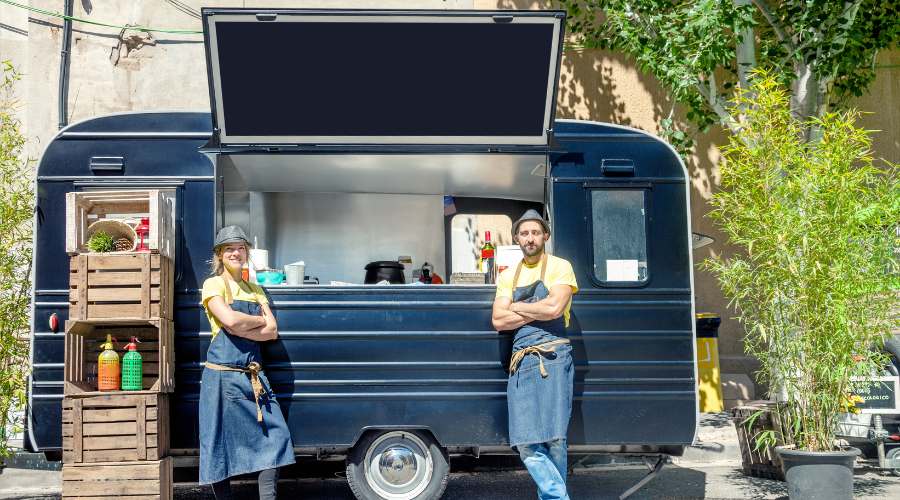The food truck industry has experienced a significant boom in recent years, with these mobile eateries becoming a staple of urban landscapes and local events.
For aspiring entrepreneurs, starting a food truck business can offer a more affordable and flexible alternative to a traditional brick-and-mortar restaurant.
This comprehensive guide will walk you through the necessary steps to successfully launch your food truck venture, from concept development to daily operations.
Planning Your Food Truck Business
Researching the market and competition
Before embarking on your food truck journey, it’s essential to research your local market and competition.
Investigate the types of food trucks operating in your area, as well as their menus, pricing, and target customers.
This information will help you identify gaps in the market and potential opportunities for your food truck.
- Analyzing local food trends and preferences: Stay informed about popular cuisines, dietary trends, and local food preferences by following food blogs, attending food festivals, and engaging with potential customers on social media.
- Identifying potential competitors: Make a list of food trucks in your area that serve similar cuisine or target the same customer base. This will help you understand your competition and develop strategies to differentiate your food truck.
- Pinpointing underserved niches: Determine if there are underserved markets or unexplored food concepts in your area. Filling a niche can help you stand out from the competition and attract a loyal customer base.
Developing a unique concept and menu
Once you’ve conducted market research, it’s time to develop your food truck’s unique concept and menu.
- Choosing a cuisine or food type: Based on your research, select a cuisine or food type that aligns with local demand, your personal interests, and your culinary skills. Aim for a menu that’s both creative and appealing to your target audience.
- Crafting a memorable brand: Develop a strong brand identity, including a catchy name, logo, and color scheme. Your branding should be consistent across all platforms, including your food truck, website, and social media profiles.
- Designing a menu that appeals to your target audience: Craft a menu that offers a balance between popular dishes and unique offerings, ensuring you cater to a wide range of tastes and dietary preferences. Consider including limited-time specials and rotating menu items to keep customers engaged.
Legal Requirements and Regulations
Registering your Business
- Choosing a business structure: Consult with a legal or financial advisor to determine the best business structure for your food truck, such as a sole proprietorship, partnership, LLC, or corporation.
- Obtaining necessary licenses and permits: Research the required licenses and permits for food trucks in your area. These may include a business license, food service license, health department permit, and fire department permit.
Navigating local food truck regulations
- Health and safety requirements: Familiarize yourself with local health and safety regulations for food trucks, such as food handling, storage, and sanitation guidelines. Regular inspections may be required to ensure compliance.
- Parking and vending restrictions: Research local parking and vending restrictions for food trucks, including designated food truck zones and prohibited areas. Some cities require additional permits for specific locations or events.
Insurance considerations
- Types of coverage needed: Obtain appropriate insurance coverage for your food truck, including general liability, auto, property, and workers’ compensation insurance.
- Estimating costs and choosing a provider: Compare quotes from multiple insurance providers and select one that offers comprehensive coverage at a competitive price.
Financing Your Food Truck Business
Estimating Startup Costs
- Vehicle and equipment expenses: Calculate the cost of purchasing or leasing a food truck, as well as outfitting it with necessary equipment, such as cooking appliances, refrigeration units, and storage.
- Initial inventory and supplies: Estimate the cost of initial inventory, including food ingredients, packaging materials, and cleaning supplies.
- Marketing and branding costs: Factor in the expenses associated with branding your food truck, such as logo design, truck wrap, and promotional materials.
Securing funding
- Small business loans and grants: Research small business loans and grants available for food truck entrepreneurs, such as those offered by the Small Business Administration (SBA) or local economic development organizations.
- Crowdfunding and investor options: Explore crowdfunding platforms like Kickstarter or Indiegogo to raise funds from supporters. Alternatively, seek investment from angel investors or venture capitalists interested in the food truck industry.
- Personal savings and bootstrapping: Using personal savings or relying on friends and family for financial support can help minimize debt and maintain control of your business.
Choosing and Equipping Your Food Truck
Selecting the right vehicle
- New vs. used food trucks: Decide whether to purchase a new or used food truck based on your budget and needs. New trucks typically offer greater reliability and customization options but come with a higher price tag. Used trucks can be more affordable but may require additional maintenance or upgrades.
- Size and layout considerations: Choose a food truck size and layout that accommodates your equipment and workflow needs, while ensuring compliance with local regulations.
Outfitting your food truck
- Essential kitchen equipment and appliances: Equip your food truck with the necessary kitchen appliances, such as a cooking range, oven, fryer, and refrigeration units, tailored to your menu requirements.
- Storage and workspace optimization: Maximize storage space and efficiency in your food truck by installing shelves, racks, and drawers. Ensure ample workspace for food preparation and cooking.
Customizing your truck’s exterior
- Designing eye-catching graphics and branding: Work with a graphic designer to create visually appealing and memorable graphics that incorporate your brand identity for your truck’s exterior.
- Deciding on paint and wrap options: Choose between paint or vinyl wrap for your truck’s exterior, taking into consideration factors such as durability, cost, and maintenance.
Marketing and Promoting Your Food Truck
Building an online presence
- Creating a website and social media accounts: Develop a professional website and establish a presence on popular social media platforms like Instagram, Facebook, and Twitter to connect with customers and promote your food truck.
- Utilizing local online directories and review sites: Register your food truck on local online directories and encourage satisfied customers to leave reviews on platforms like Yelp and Google My Business.
Networking and forming partnerships
- Collaborating with other food trucks and businesses: Build relationships with fellow food truck owners and local businesses to foster a supportive community and explore partnership opportunities, such as co-hosting events or offering cross-promotions.
- Participating in local events and festivals: Join local food truck events, street fairs, and festivals to increase visibility and expand your customer base.
Implementing creative marketing strategies
- Offering promotions and discounts: Attract customers by offering limited-time promotions, discounts, or loyalty programs.
- Hosting contests and giveaways: Engage your audience on social media through contests and giveaways, such as offering free meals for a month to a lucky winner.
- Leveraging customer testimonials and reviews: Showcase positive customer reviews and testimonials on your website and social media to build credibility and trust.
Operating Your Food Truck Business
Developing efficient workflows
- Organizing your workspace: Design an organized and efficient workspace within your food truck, ensuring easy access to ingredients, tools, and equipment.
- Managing inventory and supply chain: Implement an inventory management system to track ingredient usage and reorder supplies as needed. Establish relationships with reliable suppliers to ensure consistent access to quality ingredients.
- Hiring and training staff: Hire qualified and motivated staff to assist with food preparation, cooking, and customer service. Provide comprehensive training on food safety, customer service, and your specific menu items.
Choosing profitable locations and hours
- Scouting high-traffic areas: Identify high-traffic areas in your city, such as business districts, college campuses, or tourist hotspots, to maximize your potential customer base.
- Adapting to seasonal trends and local events: Adjust your food truck’s location and operating hours based on seasonal trends, local events, and customer demand. For example, consider catering to late-night crowds or offering seasonal menu items during holidays.
Tracking and analyzing performance
- Monitoring sales and customer feedback: Regularly review sales data and customer feedback to identify trends, popular menu items, and areas for improvement.
- Identifying areas for improvement and growth: Use performance data and customer feedback to refine your menu, marketing strategies, and operations. Continuously strive for improvement and growth in your food truck business.
Conclusion
Launching a food truck business can be a rewarding and profitable venture for aspiring entrepreneurs.








